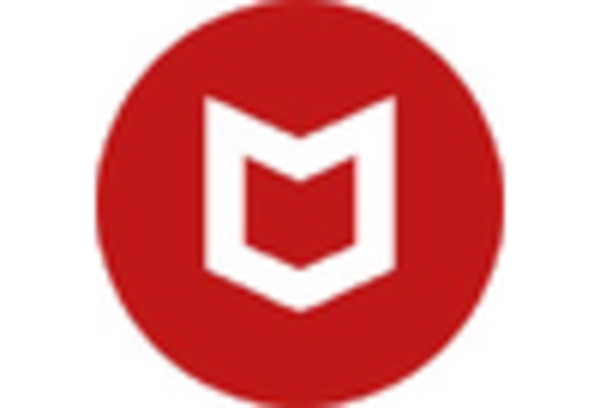The Database Security Market is currently characterized by a dynamic competitive landscape, driven by increasing data breaches and regulatory compliance requirements. Major players such as IBM (US), Oracle (US), and Microsoft (US) are at the forefront, each adopting distinct strategies to enhance their market positioning. IBM (US) emphasizes innovation through its AI-driven security solutions, while Oracle (US) focuses on integrating security features into its cloud offerings. Microsoft (US) is leveraging its extensive cloud infrastructure to provide robust security services, indicating a trend towards comprehensive, cloud-based security solutions. Collectively, these strategies not only enhance their competitive edge but also shape the market's evolution towards more integrated and intelligent security frameworks.
In terms of business tactics, companies are increasingly localizing their operations to better serve regional markets and optimize supply chains. The Database Security Market appears moderately fragmented, with a mix of established players and emerging startups. This structure allows for diverse offerings, yet the influence of key players remains substantial, as they set benchmarks for innovation and service quality.
In August 2025, IBM (US) announced the launch of its new AI-powered database security platform, which aims to proactively identify and mitigate threats in real-time. This strategic move underscores IBM's commitment to leveraging artificial intelligence to enhance security measures, potentially setting a new standard in the industry. The introduction of such advanced solutions may compel competitors to accelerate their own innovation efforts, thereby intensifying the competitive dynamics.
In September 2025, Oracle (US) expanded its partnership with a leading cloud service provider to enhance its database security offerings. This collaboration is strategically significant as it allows Oracle to integrate advanced security features into its cloud services, thereby addressing growing customer concerns regarding data protection. Such partnerships are likely to enhance Oracle's market presence and reinforce its reputation as a leader in secure cloud solutions.
In October 2025, Microsoft (US) unveiled a new suite of security tools designed specifically for its Azure cloud platform. This initiative reflects Microsoft's ongoing strategy to embed security deeply within its cloud services, catering to the increasing demand for secure cloud environments. By prioritizing security in its cloud offerings, Microsoft is not only enhancing customer trust but also positioning itself as a formidable competitor in the database security landscape.
As of October 2025, the competitive trends in the Database Security Market are increasingly defined by digitalization, AI integration, and a focus on sustainability. Strategic alliances are becoming more prevalent, as companies recognize the need to collaborate to enhance their security capabilities. Looking ahead, it is likely that competitive differentiation will evolve, shifting from traditional price-based competition to a focus on innovation, technological advancements, and the reliability of supply chains. This transition may redefine how companies approach market positioning and customer engagement in the years to come.


















Leave a Comment